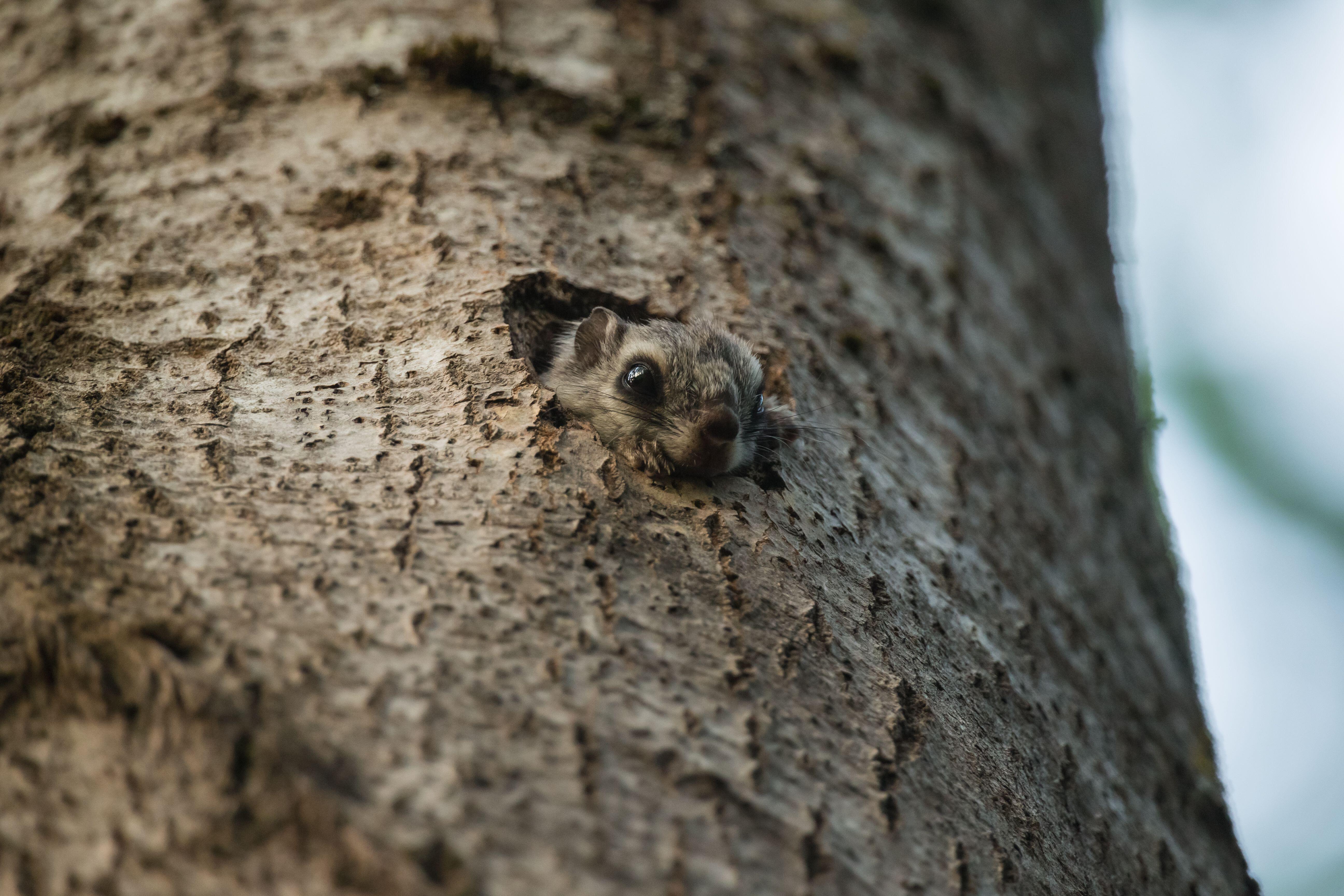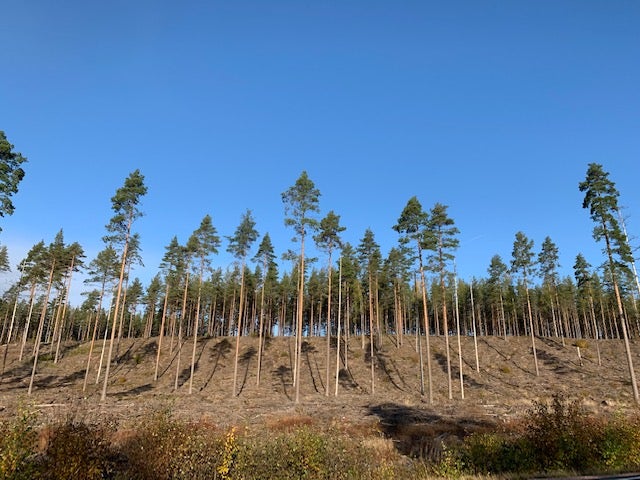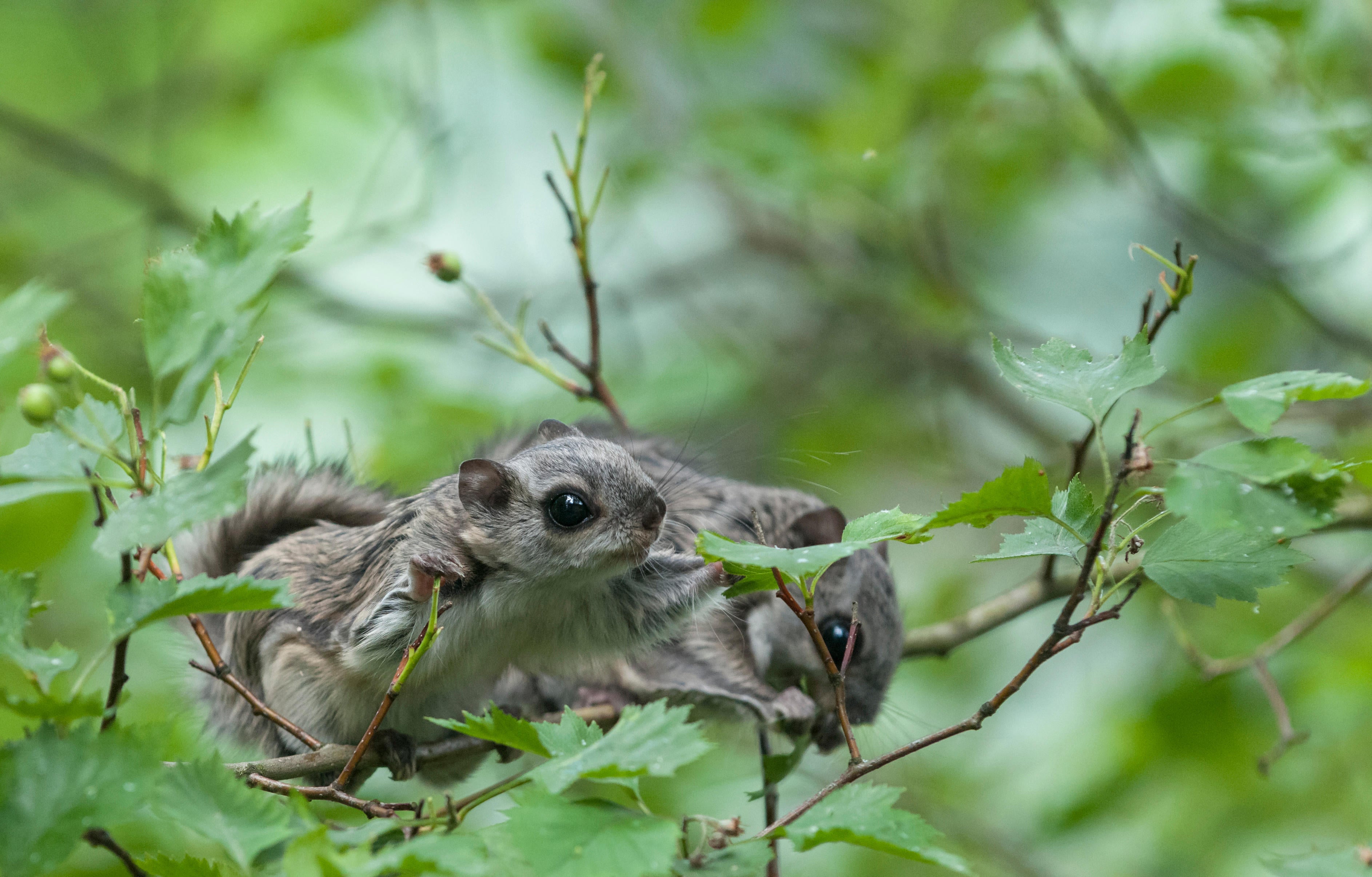On a recent overcast morning in central Finland at the Sipilanpera project site, 22km from the nearest hamlet of Multia, a small group of forestry and conservation executives gathered along a gravel road.
Crossing into stands of fall foliage, they stopped where the character of the forest changed to listen to specialist presentations.
While the talk ranged between logging, forestry law and habitat protection, the centre of attention was a diminutive if absent mammal: the Siberian flying squirrel.
With its tiny ears, immense pupils and patagium – a cape of skin extending from its front to rear legs that it uses to glide through the forest canopy – the Siberian flying squirrel is Japanese anime brought to life.
Spending its days in moss-padded tree cavities and emerging at dusk to feed, it flits from tree to tree and soars across open fields. YouTube videos show the squirrel huddling or peeking out from in its cozy home, a spritely though defenceless thing.
But in Finland, efforts to save the Siberian flying squirrel are redrawing maps of forests and cities alike.
To explore the source of these efforts is to enter a forest of contradictions. Although the Siberian flying squirrel is listed as a species of least concern by the International Union for Conservation of Nature (IUCN), flourishing in much of its expansive habitat, from the Pacific Coast of Asia, across China and Russia, its population has crashed at Europe’s door. Extinct in nearby countries, Finland and Estonia are the only EU members with remaining populations, where it is listed as vulnerable and critically endangered, respectively. When Finland joined the EU in 1995, Pteromys volans and its habitat fell under the strict protection of the EU’s 1992 Habitats Directive, pitting it against Finland’s Forest Act, guaranteeing Finns private property rights that are among the most protective in the world.
“So, we didn’t have a very detailed and nice way to proceed. [Developing the project] was based on all of the practical experiences all of us had,” says Eija Hurme, project manager of the Flying Squirrel LIFE Project, reflecting on how she and her colleagues at partner organisations decided to work together. Hurme is employed by Parks & Wildlife Finland, a division of Metsahallitus, the state-run land and waters department. The project is the EU’s and Finland’s six-year, €8.9m answer to the call to sort out the legalese and deliver guidelines on how to protect the squirrel after years of population decline. Though estimates vary, surveys suggest an over 30 per cent drop in recent decades to just 100,000.
Considering the contentious history between forestry and conservation groups, Hurme says that there was plenty of scepticism they could work together. But the stakeholders from each of these entities were – in perhaps a nod to the unique Finnish concept of sisu, or persistent determination – “patient enough to meet again and again and again.”

The squirrels use their patagium – a cape of skin extending from its front to rear legs to glide through the air (Getty/iStock)
While the outside world may snicker at a project to protect a rodent, the flying squirrel in Finland adds an incisive chapter to the planet’s saga of protecting biodiversity in the age of climate change. Often hailed as one of the most favourite nations, Finland tops the leaderboards in a range of auspicious rankings – happiness, gender equality, personal freedoms, safety, clean air – to name a few. So, if Finland, with all its abundance and freedoms, can’t save the Siberian flying squirrel, what does this tell the rest of the world about protecting its own biodiversity, especially when so many nations are locked in a desperate struggle against poverty and oppression?
“In general, countries like Finland should be able to maintain our biodiversity and even improve deteriorated habitats and species. When it comes to the [flying squirrel], it would be premature to conclude that we have failed,” Esko Hyvarinen, senior ministerial adviser at the Ministry of the Environment wrote in an email. Hyvarinen notes that, “the long history of intensive forest use in Finland has changed our forest landscape… and forests don’t change for the better rapidly.”
In a curious twist, the Siberian flying squirrel is leaving the countryside and moving into Finland’s southern cities
Indeed, the forestry industry here is a traditional livelihood. With 60 per cent of the land owned by 600,000 private households in a population of just 5.5 million, lumber is a €20bn-a-year bonanza accounting for 20 per cent of exports.
The reliance on timber has given rise to extreme silviculture where trees are farmed as rotational crops. Undergrowth is cleared and age-regimented stands of economically-valuable coniferous trees replace other species, particularly aspens, where the squirrel makes its home. And though the average size clear-cut in Finland is only 1.3 hectares, the far-reaching practice has resulted in extensive forest fragmentation that blocks flying squirrel dispersal paths and erodes overall biodiversity. One out of nine species in Finland is threatened, according to the IUCN red list. So, if the fate of the flying squirrel in Finland is rooted in forest management, saving it should buoy other species and the forest itself.
“We are looking to the forest to be the solution for climate change and all these huge things, and now trying to step into the landowners’ boots [to] understand their perspective in all of this,” says Tea Heikkinen, project coordinator at the Finnish Forest Centre, a government agency responsible for enforcing forest legislation.

Frida Bjorkman, planning officer for Metsahallitus Forestry Ltd, speaks with Anni Koskela (centre) and Eija Hurme (right) at Sipilanpera (WS Roberts)
Heikkinen also works with the flying squirrel LIFE project and says there is misinformation about efforts to save the flying squirrel. “I have had some phone calls from landowners who have found out that there’s a flying squirrel on their lands, and they asked if the government is going to kind of force themselves into the land and take it from them,” she says. “That is why the protection of the flying squirrel is not very popular.”
Sightings or evidence of flying squirrels by surveyors, citizen scientists and other interested parties, are recorded in the Finnish Biodiversity Information Facility public portal. Forests use this resource when accessing an area for cutting, and to determine whether a flying squirrel is in the neighbourhood – the database reported 1,658 sightings for 2021. But it is far from efficacious. When a squirrel is reported on land scheduled for logging, a lengthy delineation process around resting and breeding trees is required. Considering Finland’s vast forestlands, it is somewhat of a quixotic proposition to rely on landowners to discover and report an evasive animal that can adversely impact their bottom line. Researchers accessing landowner participation in reporting a squirrel’s presence on their land believe it to be very low.
Heikkinen hopes to correct this by re-engaging landowners with practical compromises that trace the fine legal line between the Forestry Act, which gives landowners the right to manage their land as they see fit, and Article 12 of the Habitats Directive, which forbids the “deterioration or destruction of breeding sites or resting places” of vulnerable species. Presently, she is working with volunteer property owners and flying squirrel experts to thin cut – as opposed to clear cut – wooded plots, as well as to extend wildlife corridors from logged land into contiguous habitat.
Driving northwest out of Helsinki along Highway E18, one encounters picturesque woods and the occasional moose crossing sign. Exiting the highway, reveals a landscape intermittently interrupted by decades of monoculture, with partitions of city-block sized clear-cuts and stands of coniferous trees with little age variation. The forest floor is often stripped of ground cover.

Forestry and conservation experts head into the woods at the Sipilanpera project site (WS Roberts)
“We call them ‘tree fields,’” says Juho Korvenoja, a farmer and rancher, whose family has owned land in the Rekijoki area for 150 years. Standing in a grove of regimented 70-year-old Norway spruce, with sunbeams piercing the canopy and a carpet of ferns underfoot, Korvenoja explains that “in the old times they only used the big trees from the forest to make buildings. Then the small wood became of interest, which is why you have these same age forests.”
Korvenoja sympathises with and profits from each side of the conservation-logging debate. When developing logging plans, he works with foresters to keep some areas wild for the flying squirrel and other species. “After the wood has been cut, then they kind of do the math on how much was left. So, I get more money from this conservation scheme. Of course, it’s a bit more trouble for me than just cutting everything.” But it’s worth it, he says.
Markus Nissinen, environmental advisor for the Central Union of Agricultural Producers and Forest Owners, an organisation representing private landowners, says reimbursement opportunities are the key. “When conservation actions are voluntary, the landowners love it,” he says, pointing to the Metso programme, a Ministry of the Environment initiative designed to arrest the decline of biodiversity by leasing or purchasing privately owned land. Metso’s aim is to bring 178,000 hectares of forest under permanent or provisional protection by 2025, according to its website.
But Nissinen also emphasises that government bureaucracy and conservation groups are often at loggerheads with property owners. “Some people don’t understand that wood has to go to the mill… and landowners have to get money.”

The Siberian flying squirrel’s large black pupils have evolved to allow more light into the retina so it can see in the dark (Alamy)
Korvenoja frames land use in terms of the generations who have shaped this area of Finland. A century ago, the countryside was all forest. Then, during the Great Depression, the land was heavily logged before giving way to small cattle farms in the 1950s. Now, the younger landowners are pushing for diverse forests to blunt climate change and enhance biodiversity. Walking into an open field, Korvenoja watched flocks of cranes migrating overhead. He says he does not understand why the Siberian flying squirrel population is dropping, nor has he seen one, but he believes that “the best policy is probably to have a bit of everything and try to mix it as much as possible.”
In a curious twist, the Siberian flying squirrel is leaving the countryside and moving into Finland’s southern cities. As Helsinki and its suburbs have expanded into surrounding forests, much of the entangled undergrowth and native wildlife have been protected. At last count, about 800 of the furry aeronauts have taken up residence in surrounding enclaves. The diverse cover offers protection from owls and martens, as well as deluxe accommodations in old growth trees drilled by the squirrel’s favourite hole-maker, the great spotted woodpecker.
And because construction zones in urban areas are under the public eye, they are also the perfect habitat for conservationists to state their case – and the courts are listening.

A shadow of itself: the last trees standing after a clear cutting near Rekijoki (WS Roberts)
Over the past two decades large housing, highway and metro line projects have ground to a halt under court orders, recommencing only after costly delays and accommodations were made for flying squirrel habitat – including rerouting, in the case of the highway. And in 2019, the Supreme Administrative Court of Finland stopped work on the Raide-Jokeri light rail line for months after a conservation group filed a complaint. But with the strict protection and enhancement of flying squirrel sites now written into the bylaws of urban planning, construction exceptions, which are allowed under Article 16 of the Habitats Directive, remain rare though hotly contested. From 2006 to 2018, in the entire country, only 37 exceptions to build in protected flying squirrel habitats were granted to land developers.
In Espoo, Finland’s second most populous city – and which has declared the flying squirrel as its official animal – old growth borders public transportation lines, loops around commercial centres, and encroaches on apartment buildings, despite many Finns’ preference for a more manicured look. Where old growth cannot be preserved, ecological corridors of mature trees, called “moving connections,” are meticulously integrated to allow the flying squirrel movement between the city’s wooded areas. The plant diversity here is in sharp contrast to forests cultivated for profit, says Laura Lundgren, environmental specialist and urban planner for Espoo.
Notoriously hard to spot, the Siberian flying squirrel dives from trees, spreads its patagium and whips across the night in search of catkins, leaves and berries
Strolling along one of the city’s many walking paths with her colleague Aino Kostiainen, Lundgren discussed the strict zoning laws protecting the city’s open space. Even as Espoo burgeons from human immigration, in the last seven years, its urban developers were granted only five deviations from the Habitats Directive. These were used to accommodate two new metro stations, apartment blocks and shopping centres.
“Of course, we would build here without the squirrel,” says Lundgren, crossing into a thicket where aspen and spruce nest boxes have been established in the hope of accommodating the animal.
In a recent telemetry study funded by the EU’s LIFE Programme, 10 flying squirrels were fitted with five-gram radio collars and their movements tracked for over a year throughout Espoo’s suburban thickets, and across 31 sq km. The study concluded that dense forest plots with trees over 20m, unbroken articulated moving connections, as well as minimal gaps between forest patches, were deemed vital to the squirrel’s survival. Although one intrepid rodent, named “Osku” by the study’s authors, managed to zip across a four-lane highway at least two times during the study.

The Siberian flying squirrel is notoriously hard to spot (Alamy)
“It has been the most surprising thing that such endangered species can live in an urban environment,” says Kostiainen. “And it can survive when it is considered in a quite small forest, when you have the right connections.”
Back in the gold and green leafed forest at Sipilanpera, the Flying Squirrel LIFE Project partners have spent the day listening to forestry testimony about how the area is being thinned according to their recommendations. The cuttings skirt a grove where the squirrel’s pellets were discovered, as well as a tree with a woodpecker hole and another holding a nest box.
Clad in knee-high boots, burgundy jacket, and wool headband, Hurme is surefooted over the rough ground, always cognisant of the countervailing forces coursing through her work here and at the 36 other project plots. For three years, the team has operated on the principle of unanimity in project planning and execution: all project members – conservation officials, landowner representatives and forestry professionals – must agree how to harvest timber and where to delineate conservation areas. The planning process involves stakeholders from the start, as opposed to simply adhering to the minimum requirements of the law. This is something Hurme considers novel in conservation work. While unity involves contentious and tedious negotiations, the results are well-informed and, Hurme says, will be honed into a best practices outreach programme for forest officers and property owners with the aim of educating and changing mindsets.

Trees are often farmed in blocks by species, with the ground stripped of undergrowth after clear-cutting (WS Roberts)
Given a landowner’s specific situation, a range of options should accommodate the flying squirrel. Continuous coverage, moving connections, and sparing deciduous trees with sustainable, mixed forests planning will be constant themes, along with the Forest Act, Habitats Directive, and reimbursement programmes.
Flora grows slower in boreal climes, and humanity’s marks seem to linger longer than in temperate zones. Sunken into the forest floor are the remains of a primitive root cellar. Old draining trenches crisscross a carpet of peat moss. Whatever Hurme’s project produces will reverberate through Finland’s forests for ages. Already there are clear signs of what might be called the “squirrel effect” – spruce and pine and birch spared the saw. And of course, this gathering of people. As her colleagues lift their gaze to the forest canopy, some measuring the trees, others perhaps in reverence, Hurme keeps a steady eye on them.
Anni Koskela, who works with Hurme as project officer, and who has studied wolves and wolverines, recalled the early, fractious days of the project. She credits the project’s partners persistence and sincerity in keeping the work on track. “We kept going and organised these meetings and now are in this quite nice place.”
Notoriously hard to spot, the Siberian flying squirrel dives from trees, spreads its patagium and whips across the night in search of catkins, leaves and berries. Its large black pupils have evolved to allow more light into the retina so it can see in the dark. And in places like Sipilanpera, the vistas of Rekijoki and suburbs of Espoo, the Siberian flying squirrel does not have to be seen to be appreciated.